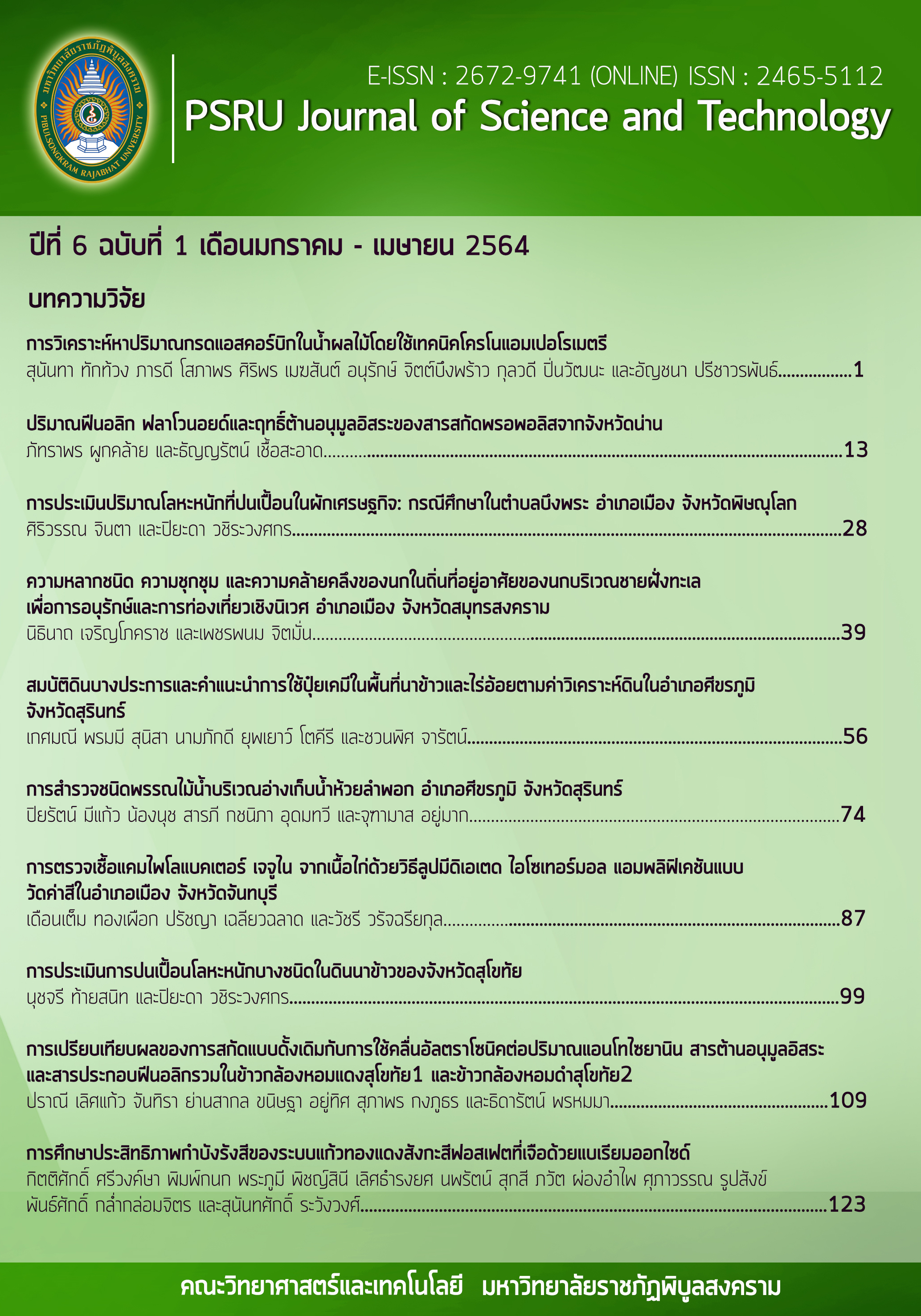TOTAL PHENOLIC, FLAVONOID CONTENTS AND ANTIOXIDANT ACTIVITY OF PROPOLIS EXTRACTS FROM NAN PROVINCE
Keywords:
Propolis, Phenolic compounds, Flavonoids, Free radical, AntioxidantAbstract
Propolis is one kind of natural substance produced by honeybees and exerts various pharmacological activities. The aim of this research was to determine total phenolic, flavonoid contents, antioxidant activity, and chemical compositions of propolis extracts. Propolis from Nan province was extracted by 70%v/v ethanol and water solvents. The extracts were determined for their total phenolic, flavonoid contents, and antioxidant activity by using the Folin-Ciocalteu colorimetric assay, aluminium chloride colorimetric assay, and DPPH radical scavenging assay, respectively. The chemical compositions of propolis extracts were analyzed with high performance liquid chromatography-diode array detector (HPLC-DAD). The results showed total phenolic and flavonoid contents of ethanolic extract of propolis (EEP) were higher significantly than the water extract of propolis (WEP) (p<0.05). The total phenolic contents of EEP and WEP were 2.890±0.018 and 1.849±0.017 mg equivalent gallic acid per g of propolis, respectively. The flavonoid contents of EEP and WEP were 0.616±0.005 and 0.531±0.007 mg equivalent quercetin per g of propolis, respectively. Moreover, EEP had
the higher efficiency to scavenge DPPH free radical than WEP, the IC50 values of EEP and WEP were 78.85 and 246.51 µg/ml, respectively. Analysis of propolis extracts by HPLC-DAD revealed the unidentical major compound at 7.1 minute retention time, which may have important biological activity. This study suggested that propolis extract, especially EEP is a source of antioxidant which might have the potential to use in drugs, dietary supplements, and cosmetics.
References
ศิริวรรณ อธิคมกุลชัย. (2551). พรอพอลิส: ของขวัญจากธรรมชาติ. ไทยเภสัชศาสตร์และวิทยาการสุขภาพ, 3(2), 286-295.
Ames, B.N., Shigenaga, M.K., & Hagen, T.M. (1993). Oxidants, antioxidants, and the degenerative diseases of aging. Proceedings of the National Academy of Sciences of the United States of America, 90(17), 7915-7922.
Bankova, V., Popova, M., Bogdanov, S., & Sabatini, A.G. (2002). Chemical composition of European propolis: expected and unexpected results. Zeitschrift für Naturforschung, 57c, 530–533.
Banskota, A.H., Nagaoka, T., Sumioka, L.Y., Tezuka, Y., Awale, S., Midorikawa, K., Matsushige, K., & Kadota, S. (2002). Antiproliferative activity of the Netherlands propolis and its active principles in cancer cell lines. Journal of Ethnopharmacology, 80(1), 67-73.
Boonsai, P., Phuwapraisirisan, P., & Chanchao, C. (2014). Antibacterial activity of a cardanol from Thai Apis mellifera propolis. International Journal of Medical Sciences, 11(4), 327-336.
Burdock, G.A. (1998). Review of the biological properties and toxicity of bee propolis. Food and Chemical Toxicology, 36(4), 347–363.
Chang, C., Yang, M., Wen, H., & Chern, J. (2002). Estimation of total flavonoid content in propolis by two complementary colorimetric methods. Journal of Food and Drug Analysis, 10, 178-182.
Easton-Calabria, A., Demary, K.C., & Oner, N.J. (2019). Beyond pollination: Honey Bees (Apis mellifera) as zootherapy keystone species. Frontiers in Ecology and Evolution, 6, 161.
Khacha-ananda, S., Tragoolpua, K., Chantawannakul, P., & Tragoolpua, Y. (2013). Antioxidant and anti-cancer cell proliferation activity of propolis extracts from two extraction methods. Asian Pacific Journal of Cancer Prevention, 14(11), 6991-6995.
Khacha-ananda, S., Tragoolpua, K., Chantawannakul, P., & Tragoolpua, Y. (2016). Propolis extracts from the northern region of Thailand suppress cancer cell growth through induction of apoptosis pathways. Investigational New Drugs, 34(6), 707-722.
Kumazawa, S., Hamasaka, T., & Nakayama, T. (2004). Antioxidant activity of propolis of various geographic origins. Food Chemistry, 84(3), 329-339.
Kumazawa, S., Yoneda, M., Shibata, I., Kanaeda, J., Hamasaka, T., & Nakayama, T. (2003). Direct evidence for the plant origin of Brazilian propolis by the observation of honeybee behavior and phytochemical analysis. Chemical and Pharmaceutical Bulletin, 51(6), 740–742.
Nagaoka, T., Banskota, A.H., Tezuka, Y., Midorikawa, K., Matsushige, K., & Kadota, S. (2003). Caffeic acid phenethyl ester (CAPE): potent nitric oxide inhibitor from the Netherlands propolis. Biological & Pharmaceutical Bulletin, 26(4), 487-91.
Nair, P., Malhotra, A., & Dhawan, D.K. (2015). Curcumin and quercetin trigger apoptosis during benzo (a) pyrene induced lung carcinogenesis. Molecular and Cellular Biochemistry, 400, 51–56.
Sanpa, S., Popova, M., Tunkasiri, T., Eitssayeam, S., Bankova, V., & Chantawannakul, P. (2017). Chemical profiles and antimicrobial activities of Thai propolis collected from Apis mellifera. Chaing Mai Journal of Science, 44(2), 438-448.
Singleton, V.L., Orthofer, R., & Lamuela-Raventos, R.M. (1999). Analysis of total phenols and other oxidation substrates and antioxidants by means of Folin–Ciocalteu reagent. Methods in Enzymology, 299, 152–178.
Siripatrawan, U., Vitchayakitti, W., & Sanguandeekul, R. (2013). Antioxidant and antimicrobial properties of Thai propolis extracted using ethanol aqueous solution. International Journal of Food Science and Technology, 48(1), 22-27.
Sun, C., Wu, Z., Wang, Z., & Zhang, H. (2015). Effect of ethanol/water solvents on phenolic profiles and antioxidant properties of Beijing propolis extracts. Evidence-Based Complementary and Alternative Medicine, 2015, 1-9.
Tiveron, A.P., Rosalen, P.L., Franchin, M., Lacerda, R.C.C., Bueno-Silva, B., Benso, B., Denny, C., Ikegaki, M., & Alencar, S.M. (2016). Chemical characterization and antioxidant, antimicrobial, and anti-inflammatory activities of south Brazilian organic propolis. PLoS One, 11, 1–18.
Usman, U.Z., Bakar, A.B.A., & Mohamed, M. (2016). Phytochemical screening and comparison of antioxidant activity of water and ethanol extract propolis from Malaysia. International Journal of Pharmacy and Pharmaceutical Sciences, 8(5), 413-415.
Widjaja, A., Yeh, T.H., & Ju, Y.H. (2008). Enzymatic synthesis of caffeic acid phenethyl ester. Journal of
the Chinese Institute of Chemical Engineers, 39, 413–418.
Woźniak, M., Mrówczyńska, L., Waśkiewicz, A., Rogoziński, T., & Ratajczak, I. (2019). The role of seasonality
on the chemical composition, antioxidant activity and cytotoxicity of Polish propolis in human erythrocytes. Brazilian Journal of Pharmacognosy, 29, 301–308.
Downloads
Published
How to Cite
Issue
Section
License
กองบรรณาธิการขอสงวนสิทธิ์ในการปรับปรุงแก้ไขตัวอักษรและคำสะกดต่างๆ ที่ไม่ถูกต้อง และต้นฉบับที่ได้รับการตีพิมพ์ในวารสาร PSRU Journal of Science and Technology ถือเป็นกรรมสิทธิ์ของคณะวิทยาศาสตร์และเทคโนโลยี มหาวิทยาลัยราชภัฏพิบูลสงคราม และ
ผลการพิจารณาคัดเลือกบทความตีพิมพ์ในวารสารให้ถือมติของกองบรรณาธิการเป็นที่สิ้นสุด







